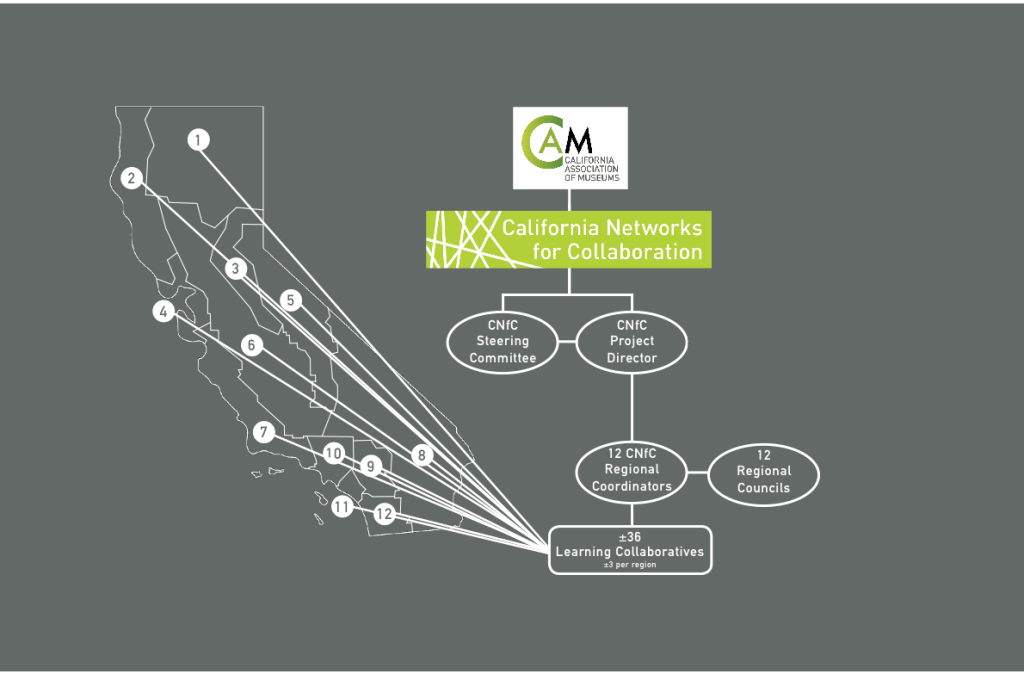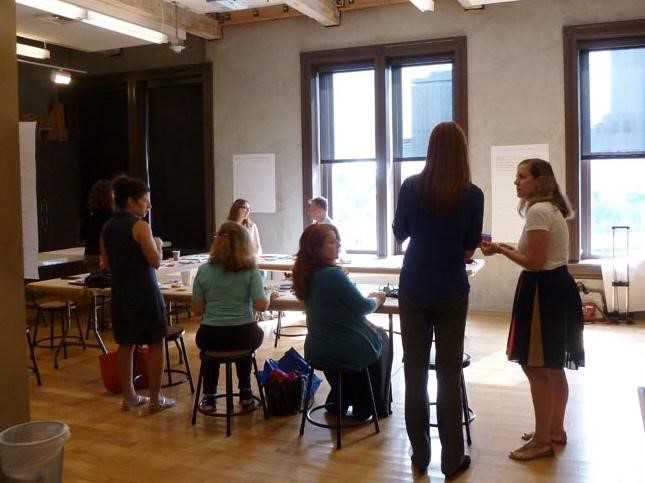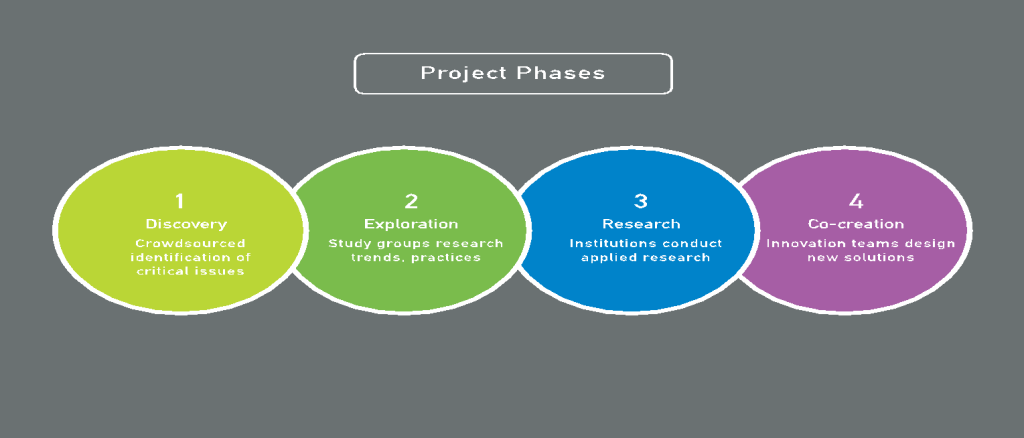
Museum associations, like the organizations they serve, face significant shifts in responding to 21st-century learning models that emphasize opportunities for building new skills and practices in self-directed, participant-centered, and multi-directional learning environments. Mindful of these shifts and sensitive to the need for providing local opportunities, the California Association of Museums (CAM) and 13 other partner organizations across the state joined together to reimagine and pilot a dispersed learning model for professional development and statewide collaboration in order to solve pressing issues within the museum field.
This initiative is aptly entitled the California Networks for Collaboration (CNfC), for as its name suggests, the project is designed to employ collaboration throughout its four, distinct, multi-year phases:
We have now concluded the second phase of the project, Exploration, in which professional networks were leveraged to convene 34 study groups. Through this process, we learned a lot about collaboration and managing a dispersed learning model for professional development across a vast geographical region.

The final report for CNfC Phase 2 details our project model findings (outlined in the above image) as well as key content findings revealed by program participants – museum colleagues throughout California –who, over a six-month period, investigated the three topics derived from the overarching CNfC focus of Connecting with People: Accessibility, Audience Research, and Engagement Strategies.
While the California Networks for Collaboration represents an ambitious endeavor from multiple perspectives, this blog post focuses on the final takeaways that participants documented from phase 2 to share across the field.
What Is Collaborative Learning?
To emphasize the collaborative nature of the CNfC professional development offerings, we named them “Learning Collaboratives”. We intentionally sought to provide more collaborative experiences for CNfC learning community members than what might be expected of the traditional study group or professional development experience.
This chart, originally created by Marsha Rhea, President of the association consultancy firm Signature i, LLC, compares collaborative learning environments to those that are more traditional:
| Learning Collaborative | Study Group |
| Knowledge co-creation focuses on participant meaning making | Knowledge transfer focuses on participant comprehension |
| Participant-centered | Facilitator-centered |
| The atmosphere is social and organic | The atmosphere is more structured and predefined |
| Participant experience is interactive –
“Ask me!” |
Participant experience is more passive –
“Feed me.” |
| Context rich | Content rich |
| Driven by participant interests | Driven by facilitator’s (or expert’s) interests |
From this overview, we designed the Learning Collaborative experience for professional groups over a period of six months with the following blended program offerings:
Each Learning Collaborative participant was extended opportunities for
- Meeting together in person once a month
- Participating in a social networking forum between meetings
- Attending live, monthly webinars with museum thought leaders
- Reviewing a curated list of recommended readings and optional activities outside of meetings
The in-person meetings tended to be the most important anchor for the Learning Collaborative experience. These meetings often included a number of different interactive protocols for a diversity of spoken and written interactions to help construct shared learning. The following images depict the Learning Collaboratives in action and help to illustrate the breadth of the collaborative protocols that shaped the learning experience:




As we later learned from project evaluations, the opportunities that emphasized intentional networking, collaborative meaning-making, and applying shared learning to practice were the most impactful. Specifically, we found that participants most valued the case study visits (in month four) and crafting final “knowledge products” at the conclusion of the project.
Learning Collaboratives’ Recommendations for the Field
In their final months of convening, each Learning Collaborative group worked to document their most salient learnings. These conclusive takeaways, what we called “knowledge products”, took on many different forms – any static form that the Learning Collaborative thought best – from checklists to interactive Prezi presentations, to games and annotated bibliographies. (You may access all 37 of the CNfC Learning Collaborative knowledge products here.)
Here is a brief sample of just one knowledge product per each topic of study:
Accessibility Knowledge Products
The Accessibility Learning Collaborative curriculum was intentionally developed to expand concepts of museum accessibility by sharpening awareness for the cognitive and physical vulnerabilities presented within the Americans with Disabilities Act (ADA), and to join this with sensitivity for cultural inclusiveness, from matters of personal identity to broader definitions of “family” and “community.”
For planning museum exhibitions and programming, the Central Coast region created a trifold guide organized by the acronym “ACCESS” (Audience, Comfort, Culture, Engagement, Socioeconomic, and Special Needs) in which each section provides a series of questions for self-evaluating programs and operations.
Audience Research Knowledge Products
The Audience Research Learning Collaborative curriculum was designed to help participants think “evaluatively” by leading them in creating their own research instruments, for both traditional (e.g. surveys) and creative (e.g. graffiti walls) methods. This design was centered on the premise that we learn best by doing. Participants designed simple evaluation studies and practiced prototyping these and creating several iterations based on feedback from their respondents––a process central to and a best practice for designing sound evaluations studies.
The Orange County region compiled a museum practitioner’s guide for designing and implementing audience research. This knowledge product is presented as a one-page summary for those who wish to hit the ground running and is followed by a more in-depth, step-by-step guide from focusing the primary research question to relaying findings to stakeholders.
Engagement Strategies Knowledge Products
Curriculum for the Engagement Strategies Learning Collaborative was crafted on the foundation that a range of meaningful museum engagement practices stems from the unique relationship between a museum and its audiences.
What could be more engaging than playing a game to better consider the many perspectives and roles in making museums more engaging? The San Francisco region crafted this card game to help foster empathy between allies and those who may resist change. Use the cards to shape conversations and encourage players to expand their perspectives.
(Curious for more? Listen to Learning Collaborative participants from different regions reflect on their knowledge products, learning experiences, and professional applications for the Engagement Strategies study here, the Audience Research study here, and the Accessibility study here.)
How Might We Carry This Work Forward?
Each Learning Collaborative group produced a knowledge product with the intention to share their thinking with all of us in the greater museum field. There are many additional knowledge products to explore and potentially even incorporate into your own practice! (Again, all the knowledge products are here.)
We invite you to reflect on your own professional practice, just as Learning Collaborative participants co-created their learning and then documented their takeaways to help us move our collective work forward in building more responsive, accessible, and inviting museums:
- What are the characteristics of the most collaborative projects you’ve been a part of? How might you infuse your own professional practice with these characteristics, too?
- How might your own work, interdependent within your organization, networks, and the greater field, help to create more inclusive museums?
- How might we invite our communities and stakeholders at all levels into more collaborative experiences and learning environments that focus on shared meaning making?
The California Networks for Collaboration is certainly engaged in answering these and similar questions as a networked state working to collaboratively address how museums can best connect with people. While we look forward to the upcoming CNfC phases for collaborative research and finally co-creating and innovating new solutions across the state, we welcome your insights, inspirations, and quandaries. Let’s open a discussion in the comments section, below!
This project was made possible in part by the Institute of Museum and Library Services, grant number MG-10-14-0010-14, and with the generous support of all CNfC partner organizations.
About the Author
Ivy Young joined the California Association of Museums (CAM) in November 2014 to direct the California Networks for Collaboration, a project funded by the Institute of Museum and Library Services. Her comprehensive experience in education and art informs Ms. Young’s collaborative spirit and her current work as a learning design and facilitation consultant. In addition to CAM, she has worked for ArtRise Projects, Gail Anderson & Associates, and the Balboa Park Cultural Partnership.












